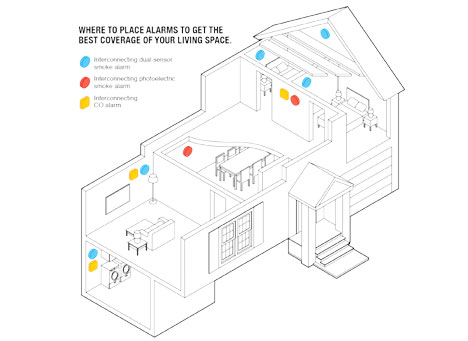The answer is YES - you need both as installing and maintaining smoke and carbon monoxide (CO) alarms can save your life and that of your loved ones. Luckily, they're inexpensive and easy to install.
Basic smoke alarms start at $15, with combination smoke and CO alarms costing about $45 and up. Many newer and more expensive models offer more features. For example, digital displays and interconnected smoke alarms that communicate between devices and provide integrated, whole-house protection. Whether the alarms are hardwired or wirelessly connected, with such a system when one alarm detects smoke or CO, all of them will sound.
Smoke alarms are a must in all homes, and CO alarms are needed for any home with fuel-burning appliances such as a furnace, water heater, range, cooktop, or grill. Even those living in all-electric homes should install CO alarms, because CO can seep into the house from an attached garage or if a backup generator is used too close to your living quarters in the event of a power outage.
You'll need smoke alarms that detect flaming and smoldering fires for each bedroom, with at least one alarm installed on each floor, including a finished attic and the basement. You should also have a CO alarm on each living level, in the basement, and near (not inside) an attached garage.
Before you shop, check regulations in your region. What you need, including types of alarms and their placement, can vary. Also, some insurance companies offer a 5 percent discount for homes with smoke alarms.

Fires burn differently: Some flare, some smolder. Make sure you purchase a smoke alarm that can detect both types of fires.
Ionization Smoke Alarms are best at detecting the small particles typical of fast, flaming fires but in our tests, all tested poorly for detecting smoky, smoldering fires. Ionization units are prone to false alarms from burnt food and steam, so don't mount them near a kitchen or bathroom.
Photoelectric Smoke Alarms are best at detecting the large particles typical of smoky, smoldering fires but poor at detecting fast, flaming fires. Photoelectric units are less prone to false alarms from burnt food and steam, so you can install them safely around the kitchen or bathroom.
Dual-sensor Smoke Alarms combine ionization and photoelectric technology to save you the hassle of installing two separate smoke detectors. But you will still need to install CO units.
For the full story from Consumer Reports Magazine, click on the link below – or copy and paste it to your browser.
http://www.consumerreports.org/cro/co-and-smoke-alarms/buying-guide.htm